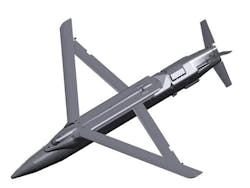The XQ-58A Valkyrie, a prototype for a long-range unmanned drone, completed its first flight on March 5 at the Yuma Proving Grounds in Arizona. It was designed and built by the Air Force Research Laboratory in conjunction with Kratos Unmanned Aerial Systems, a company that has earned a reputation for building reliable drones. The two organizations took just 2.5 years to bring the program to its first flight test.
The multi-mission XQ-58A was designed to handle surveillance, strike, electronic warfare, and fly missions independently as part of an autonomous and cooperative swarm of drones, or as a “loyal wingman.” Loyal wingman is a new concept, defined as having a piloted combat aircraft (most likely an F-22 or F-35) fly and control a drone during a mission.
The drone is said to have a range of over 2,000 miles, a mission ceiling of about 45,000 ft, and a top speed of 652 mph (Mach 0.85). It can carry up to 500 lb of bombs, most likely two Small Diameter Bombs (GBU-39/B) in ,an internal bay or under each wing.
The GBU-39/B Small Diameter Bomb (SDB) from Boeing is a 250-lb precision-guided glide bomb. It was designed to let combat aircraft carry several more bombs than what was one standard. For example, most U.S. Air Force aircraft can carry four SDBs in place of a single 2,000-pounder. The bomb is highly accurate and can guide its descent using inertial navigation or GPS, and home in on targets using radar, infrared, and semi-active laser guidance.
The single-engine jet was also designed with stealth in mind. It is relatively small—almost 29-ft long with a 22-ft wingspan. It also has a trapezoidal fuselage with a chined edge, V-tails, and an S-shaped air intake, all of which should reduce its radar and IR signature. The XQ-58A was built rugged enough to take off and land from rough airfields, which are common forward combat areas. It can also be launched using rocket boosters instead of a runway.
The XQ-58A is part of the Air Force Research Laboratory’s Low Cost Attritable Aircraft Technology (LCAAT) portfolio. Its goal is to stop and possible reverse the escalating cost trajectory of tactical aircraft. LCAAT’s objectives include designing and building drones faster by developing better design tools and maturing and leveraging commercial manufacturing processes to reduce build time and cost. LCASD aims to eventually field optionally reusable, highly adaptable, low-end unmanned combat air vehicles for $3 million apiece for batches of up to 99 aircraft per year, or $2 million each for yearly orders of 100 or more. In essence, the LCAAT concept is “high-volume” both in in terms of the strategy behind it and of procuring it affordably.


